In 1897, a decree of the Most Holy Governing Synod of the Russian Orthodox Church established the Russian Ecclesiastical Mission in Korea for the purpose of providing pastoral care to the Russian Orthodox Christians who resided in the Korean peninsula while also preaching the Orthodox faith to the people of Korea as a whole. The mass emigration of native Koreans to the Russian Empire in the late 19th and early 20th centuries had also made the establishment of the Mission desirable. In 1903, the Church of St Nicholas was consecrated in the city of Seoul. However, in 1905, Korea became a Japanese protectorate and in 1910 was officially incorporated as a part of Japan. Church encountered many difficulties as a result of Japan’s annexation of Korea. Nevertheless, by the time of the Russian Revolution of 1917, the Korean Ecclesiastical Mission numbered five parishes in the provinces (apart from Seoul) and a few hundred faithful.
From 1918, the loss of financial support from Russia meant that the work of the Mission was severely restricted. There were attempts to revive Korean missionary activity in the years of 1936-1939, and the construction of the Resurrection Church on the Novina Estate, by the ROCOR Kharbin diocese, which is the subject of this publication belongs to this period.
In 1941, all divine services in the Korean language were prohibited by the Japanese administration in Korea. On 8 October 1941 Metropolitan Sergii of Tokyo, having already been removed by the Japanese authorities from his diocese, was now also forced to resign as the head of the Korean Ecclesiastical Mission. Fr Polycarp (Priymak) was elevated to the rank of archimandrite and appointed in his place.
In 1945, at the end of the Second World War and the Korean occupation, Christians from the northern parts of the country began to experience persecution. This contrasted with the support offered by the Americans in the south and resulted in a “religious migration” of Christians to the south of the peninsula. Thus in the post-war period, the Korean Ecclesiastical Mission located the focus of its activity to the south.
On 11 August 1945, the Mission was placed under the authority of the Moscow Patriarchate’s East Asia Exarchate and on 27 December 1945 a patriarchal decree declared it “temporarily self-governing” under the administration of Archimandrite Polycarp. Although Fr Polycarp was later able to re-establish the Mission’s links with the patriarchate, the new South Korean government, as well as many Russian emigres and the committee of the Korean faithful called for the Mission to leave Moscow’s jurisdiction.
In October 1948, the Korean Deacon Alexis Kim Yi Han was ordained as a priest by Archbishop Benjamin (Basalyga, of North American Metropolia) in Tokyo and appointed as head of the Ecclesiastical Mission. On 12 December 1948, after his return to Korea, Fr Alexis Kim took over the Mission with the help of the police and his own supporters. Fr Polycarp was charged with being a Soviet spy and placed under arrest. On 29 June, he and his elderly mother were escorted under armed guard as far as the 38th parallel and thence sent to exile in North Korea. Fr Polycarp found a temporary refuge in Harbin and was later confirmed as the Head of the Russian Ecclesiastical Mission in Jerusalem (from 1957, he served as a bishop in the USSR)
With the arrival in Korea of a Greek Orthodox military contigent a chaplain who came as part of the UN peacekeeping force, a Korean Mission of the Patriarchate of Constantinople was established – later to be reformed into the Korean Exarchate.
In 2006 the Church of the Lifegiving Trinity (Moscow Patriarchate jurisdiction) was consecrated in Pyongyang, North Korea. The Russian Orthodox Church Outside of Russia has an active Mission in South Korea. The total number of Orthodox Christians in Korea is approximately 3,000 people. This anonymous article was published in issue 10 of Khleb Nebesnyi for 1937. Most certainly its author was Archimandrite Vasilii (Pavlovskii), who died in 1945 as a ROCOR bishop of Vienna. After the Soviet Army advance into the North Korea, the founder of the church in Novina Yuri M. Yankovsky was sent to the USSR and end his life in Gulag. His son Valery also went through imprisonment in Russia and died in Vladimir in 2010 shortly before his 99th birthday. Another son Arsenii and daughters Muza and Victoria died in California. You may learn about the history of Russian Church in Korea between the war and of the Yankovskys from D. N. Clark, Vanquished Exiles: the Prewar Russian Community in Korea, in Korean Studies:New Pacific Currents, 1994.
Archpriest Dionisii Pozdnyev, 2018
Many sufferings and trials have befallen the Russian Orthodox faithful in our times. They have borne grief and losses, but amid life’s storms and tribulations, in the terrible tempest of the dark forces of the sinister master of this age, the holy Russian soul does not forget its sacred rock of faith and foundation, its Orthodox Church and strives, surrounded by foreign peoples and languages, to hear the familiar sound of church singing within the walls of its own Orthodox church.
During the glorious reign of our Father the Tsar, there was a famous property owned by Yu. M. Yankovsky near Vladivostok. Yankovsky was a well-known hunter, who managed to create a cultural corner. He was known mainly for his outstanding reindeer stud farm, where he bred expensive spotted reindeer, sold their antlers and cultivated a market garden.
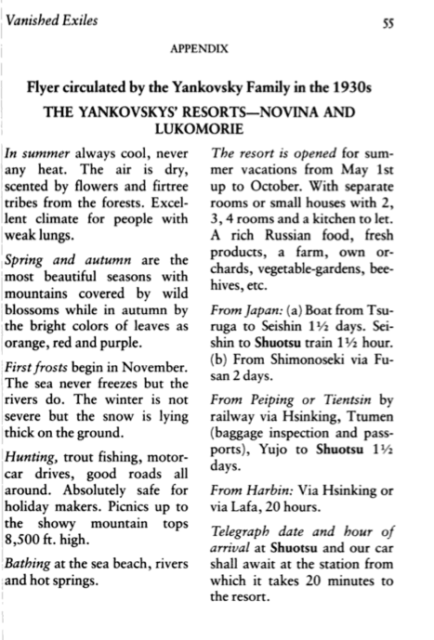
An advertisement for Novina Hunting Lodge and safaries. Photo: Donald Clark, Vanquished Exiles
But with the coming of the Bolshevicks, all that was destroyed, and Yankovsky had to flee for his life with his family to North Korea. Eventually, fifteen years ago, he chose “Novina” as a permanent place of residence. This was a deep, wild gorge along the Omno River. A look at the “Three Chalices” waterfall some 25 versts from “Novina” shows just how remote this area was. One had to edge sideways along the “Novina” gorge in the province of Shuotsu from the town of Seisin.
The spacious hut he built for residence with a small attached dining room was washed away in a flood of the Omno mountain river after copious rains. The family barely managed to escape with their lives, at a time when Yankovsky was away on a hunt in the taiga.
However, he did not lose heart. He detonated the cliff that narrowed the flow of the river and built a hanging bridge across it, that attracted tourists by its enchanting appearance. At present, “Novina” is a cultural oasis in the Shuotsu province of North Korea, some 2 ½ hours’ travel from Seisin.
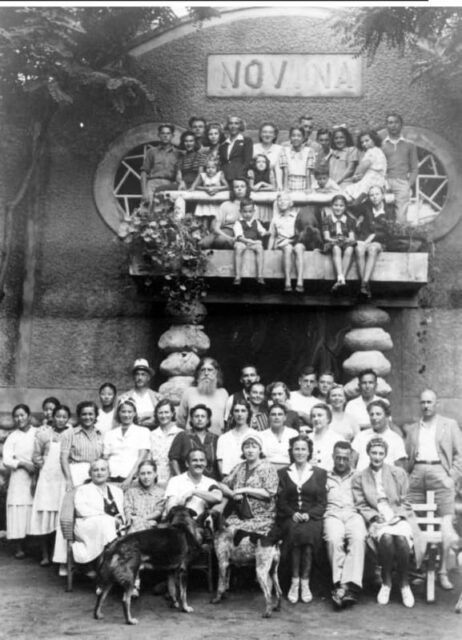
Dacha dwellers in front of theatre and club Novina. Y. M. Yankovsky with a dog in the front row. 1937.https://koryo-saram.ru/
Twenty five dachas have been built along the gorge and some Korean villages. “Novina” itself boasts a reindeer stud, an apiary, apple, cherry and pear orchards, as well as raspberry canes and gooseberry bushes.
Yankovsky’s late wife Margarita Mikhailovna wanted to build a church. Her Orthodox soul could not live without an Orthodox church, and as soon as the opportunity arose, she had the church foundations laid. All this in forest-covered mountains. The church stands in a clearing on the mountainside and is reached by 30 stone steps. Its walls were constructed of round boulders brought by dacha owners coming to “Novina” to escape the heat of Shanghai, the dust of Harbin and the stuffiness of Tseintsin. Money was gathered by subscription, but Yu.M. Yankovsky had to spend his own money as well, and it was his labor and energy, and his late wife’s wish that brought about the creation of this beautiful church of the Resurrection of Our Lord in such a flowering and picturesque corner of North Korea.
The church was consecrated on 25 July. This is how E. Voyeykova, a reporter on the “Rubezh” magazine described the proceedings in No.33 dated 14 August 1937:
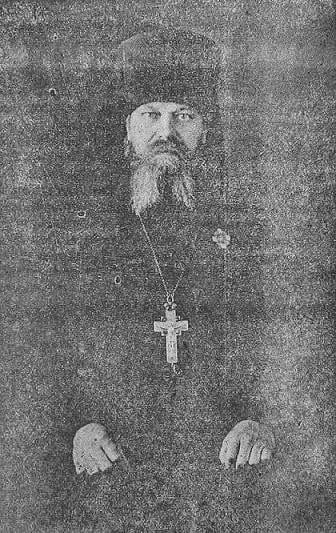
Archimandrite Vasilii (Pavlovskii). Photo: Khleb nebesnyi
“On Sunday 25 July there was a great gathering of people at the resort location ‘Novina’ in North Korea from all neighboring towns and settlements to witness the triumphal opening of the newly-built church of the Resurrection. The deeply moving service by archimandrite Vasili, the magnificent voices of the choir, the deeply reverent attention of those present of other faiths and the prayers of the Orthodox faithful residents of Korea, many of whom had been unable to attend church for years – all this created an extraordinary atmosphere. The great need for such a church was expressed by one of the women present: ‘When my children were taken to an orphanage in Shanghai after my husband’s death (may God bless the good people who helped), they were baptised there, my son was seven years old, and my daughter – nine…’
Why did she not have them baptized sooner? she was asked and answered: “We lived in Korea, far from any church. Harbin was too far away…there is a church in Seoul now… Father Polycarpus came from there last year, and he had to baptize six people immediately, Russians and Koreans. But now we have a church here. I still cannot believe it! Here I stand, praying and shivering all over. What a joy, what a great joy!”
Many people came together on that lovely, hot summer morning around the church on Novina hill. The Briners came from Ryuken [1] the family of the American actor Yul Brunner , the Ostroumovs, Chevakinskys, Igantievs, Korenevs, Kurzhanskys, A.B. Enns, E.A. Val’kova, Yuzefovich…From Seisin came Dolmatov, G.V. Shevelev, R.V. Rimsha, G.N. Gusakovsky, Victoria Yankovskaya, Syrokvashins…From Nanyo came the Chirikov family; from Kanyu – M. Kazantsev…All the residents from neighboring dachas – the Korenevskys, Hintze, Unterbergers, Chradyntsevs, Krivoshis, Shevelevs, Kantors, Maltseva – all attended the celebration. Obviously, all the people from Yu.M. Yankovsky’s dachas were there.
With understandable trepidation, the faithful followed the service of consecration which Fr. Vasili celebrated with the assistance of the main craftsman behind the construction of the church, Yu.M. Yankovsky.
It seemed miraculous that here, in the very place to which stones had been brought not so long ago, the ceiling was mounted, the silvery dome was raised and slim white birches were planted all around. The sanctuary lamps gleamed brightly, and the world’s most beautiful hymns of the Orthodox service filled the air.
Many people contributed, many did as much as they could for the building of this new church, but the main credit must go to the master of “Novina”, who faithfully carried out the dying wish of his wife. The church at “Novina” became the final legacy of Margarita Mikhailovna Yankovskaya. It took only a few months for Yu.M. Yasnkovsky, aided by E.M. Brynner and N. Ya. Dolmatov to gather a substantial sum for this godly task and lay the first foundation stone of the new church. Provision of icons, church vessels, vestments and books was the work of the indefatigable E.M. Brynner, while the raising of the dome, every stone, nail and pillar was the work of Yu.M. Yankovsky.
This first and only church in North Korea is remarkable for its exceptionally original architecture… Thirty stone steps… Enormous vases of nasturtiums… Beautiful entry door covered with the bark of century-old oaks laced with moss…A white birch cross placed above the door… A small green twig remains on one of the birchwood pillars…A dome surmounted by a gleaning cross.
The interior walls consist of dark undressed stone, supported by birchwood pillars that form a frame for the Royal Gates and icons written by Mother Olympiada from the Harbin House of Mercy.
This small, unique church, set in the wonderful surroundings of Korean hills draws the attention of the faithful, and Fr Vasili is constantly serving parishioners’ requests for intercession and memorials. The church at “Novina” must satisfy the spiritual needs of all the faithful in the area.
There were numerous small communicants on the opening day of the church, children of local residents, and adults and children alike took part in the procession of The Cross. It is hard to find words to describe the beauty of that procession!… How magnificent are the surroundings of the church! Pine trees and larches, bright blue sky above, green hills on every side. All the residential buildings – dachas, the reindeer farm, the apiary – lie below, whereas here, on the hill one feels far removed from everyday cares, closer to God, closer to a clam and clear vision. It should be noted that dacha residents have formed a choir, conducted by N.I. Yankovskaya. This choir includes E.V. Maltseva, M.Yu. Potapova and V.N. Volkov. Subsequently, O.V. Apreleva became a permanent member of the choir. The duties of the church warden were entrusted to O.M. Mezhak.
After consecration of the church, services were held on Sundays and church feast days. The dacha residents of “Novina” and Lermontovye were keen to attend all the services.
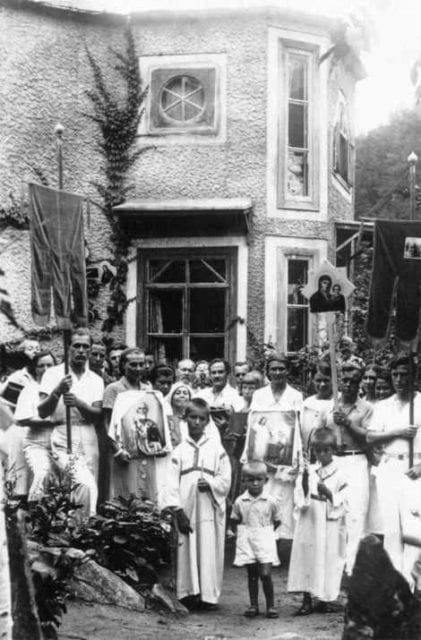
Procession for the blessing of the water. Aug. 1/14, 1938. Banner holders are Arsenii, on the left and Valerii on the right In front in a sticharion little Misha Hintze. Yu. M. Yankovsky behind him 1938. Photo: https://koryo-saram.ru/
On one occasion the church had to be opened in the middle of the night for a service of intercession for those who had vanished without a trace in Soviet Russia. Russian Orthodox people brought their joys and sorrows to this church, seeking God’s help and salvation in times of trouble.
On 1 August (old style) a cross-bearing procession went to the Omno River. The glorious liturgical singing hung in the air above the river, which bore an amazing witness to the blessing of the waters. Every soul rejoiced.
On 1 September (old style) a memorial service took place for M.M. Yankovskaya and Yu.M. Yankovsky’s mother, Olga. The dacha season was drawing to a close. People were returning to work in the towns, but the church remained in the expectation of a new priest to take over.
God grant that services in this church will never cease and the Name of The Lord will be heard and strengthen the faith of the local people.
His Eminence Metropolitan Meleti has expressed his approval of the work of Yu.M. Yankovsky in building the church, and E.M. Brynner for the provision of icons and church vessels, awarding both an archbishop’s certificate of appreciation. May the days of all those involved in the building and outfitting of this church be blessed.
Translated by Alyona Kojevnikov
References
| ↵1 | the family of the American actor Yul Brunner |
|---|

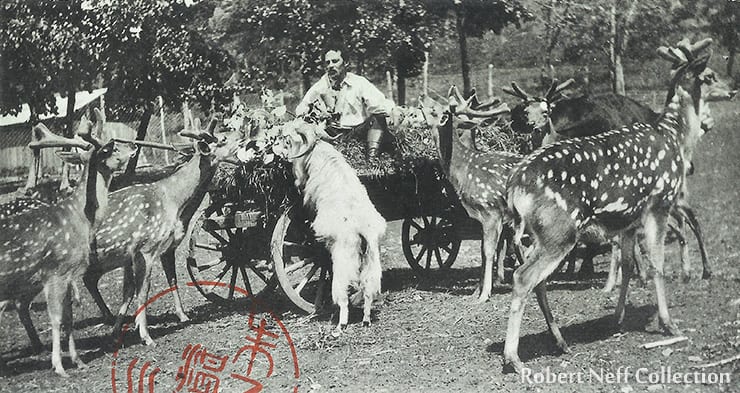










There’s a slight error in the 7th paragraph of that article. It wasn’t the UN Peacekeeping Force (PKO), but the United Nations Forces (UNC), that have been here in Korea since 1950. PKO and UNC are very different organizations. Among the UNC was the Greek Expeditionary Force (“Sparta Battalion”).
Thank you for the good article. It was a good reading.